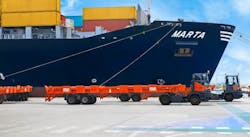Does it seem like it’s taking longer than normal for those container loads of tires that you’ve ordered from Asia to arrive? Well, that’s because it is - thanks to what some are calling “a perfect storm” of interconnected events that have constrained shipping capacity coming out of that region.
Tire manufacturers, tire distributors and tire dealers throughout North America have been struggling with the knock-on effect of this scenario since last year. And we’re still in choppy waters.
Here’s what happened, according to Martin Dixon, director of research products for Drewry, a leading provider of research and consulting services to the shipping industry, with offices in the United Kingdom, India, Singapore and China.
“Volumes shipped by retailers and manufacturers collapsed during the first half of 2020 and inventories were run down as the global economy shut down in response to the COVID-19 outbreak,” he says.
Shipping lines responded to severely reduced demand by slashing their vessel capacity.
“This had the side effect of disrupting the recycling of empty shipping containers from key destination areas, such as North America and Europe, back to origin centers” in southeast Asia.
Then the North American economy experienced a sharp, earlier-than-anticipated rebound as the third quarter began.
Rising demand coupled with already-reduced shipping capacity soon “bottlenecked the entire supply chain,” according to Ron Papcun, senior vice president of operations for Sumitomo Rubber North America Inc.
The problem was compounded by “the seasonal holiday surge we see every year,” he says.
And what a surge it was.
The Port of Los Angeles reported that a late-year spike in consumer demand helped boost its “volumes to near-2019 levels, making 2020 the fourth highest-volume year” in the operation’s history.
During the week before Christmas, the port, which is the biggest in the U.S., handled nearly 95% more traffic than it processed during the same period in 2019.
The net result of these developments was “a significant container imbalance,” made worse by North American port operators’ inability to respond quickly to the situation, which ultimately had “two significant effects,” according to Papcun.
“One was delays in getting inventory from Asia” - in some instances, anywhere from two to four weeks.
“In the U.S. - between the independent tire dealer, the tire wholesaler and the tire manufacturer - there is typically a lot of buffer inventory in the pipeline. But a lot of that has been depleted.
“The other thing is that rates to ship products over here from Asia are skyrocketing,” says Papcun. “They are at a five-year high.”
According to the Freightos Baltic Daily Index, in early-January, Asia-to-West Coast shipping rates hit a historic apex of $4,189 per 40-foot container.
“And in particular, spot market rates are surging.”
Where does this leave tire dealers and distributors who are caught in the middle?
Papcun says there are steps you can take to help mitigate the ongoing impact.
“Diversifying your supply base is a good idea, if you can afford to do that. And if you can, take on additional safety stock.”
Most importantly, know that the situation will improve. “There’s always a lag and then there’s an over-reaction, but I would guess that during the second quarter, things will start to normalize,” says Papcun.
Drewry’s Dixon agrees. “We expect capacity constraints to recede through the second quarter, which will lead to a decline in spot freight rates from current highs,” he says.
“The container equipment availability shortage is temporary. We expect this situation to right itself as supply chains and carrier schedules normalize, assisted by a seasonal slowdown in trade” after the Chinese new year holiday in February.
So don’t “give up the ship." Relief is on the way, hopefully sooner than later.
About the Author
Mike Manges
Editor
Mike Manges is Modern Tire Dealer’s editor. A 28-year tire industry veteran, he is a three-time International Automotive Media Association Award winner, holds a Gold Award from the Association of Automotive Publication Editors and was named a finalist for the prestigious Jesse H. Neal Award, the Pulitzer Prize of business-to-business media, in 2024. He also was named Endeavor Business Media's Editor of the Year in 2024. Mike has traveled the world in pursuit of stories that will help independent tire dealers move their businesses forward. Before rejoining MTD in 2019, he held corporate communications positions at two Fortune 500 companies and served as MTD’s senior editor from 2000 to 2010.

